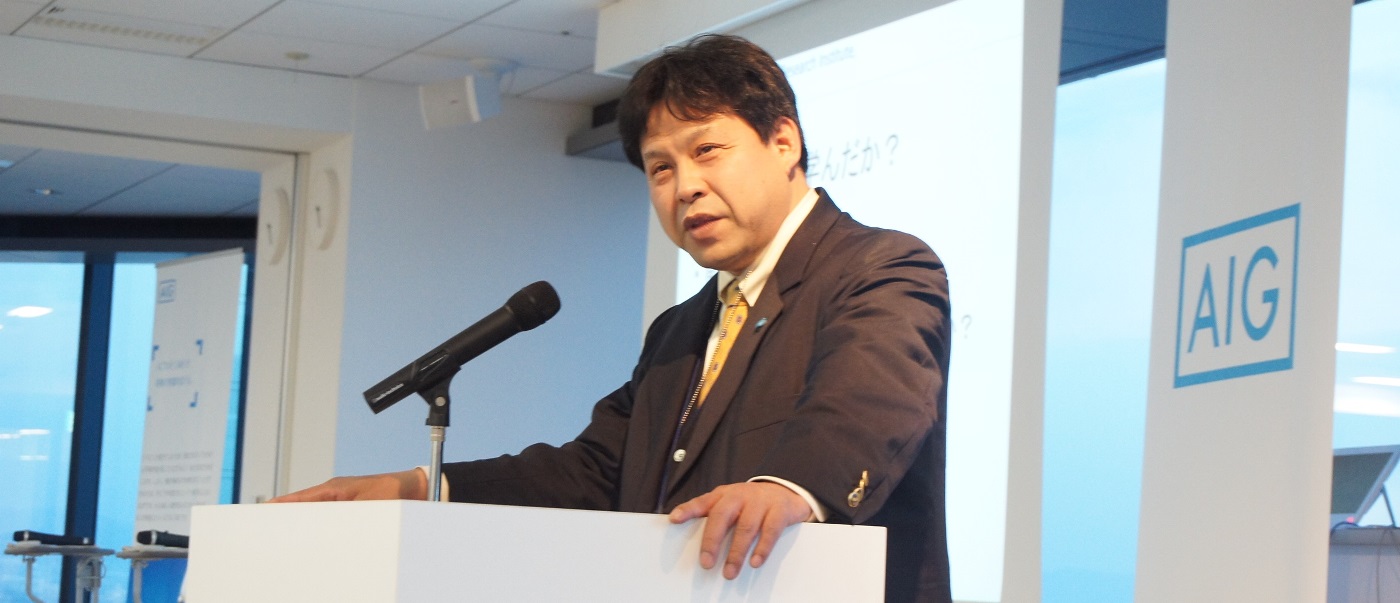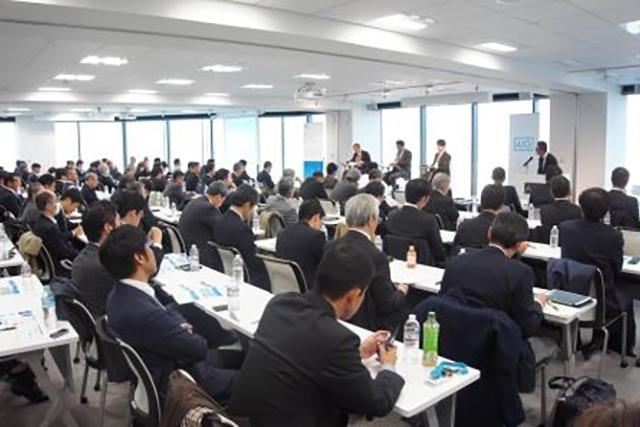2018年3月12日
第1回AIG総研フォーラムを開催 「南海トラフ地震に備える-財政リスクを踏まえた総合的事前対策」/“Preparation for Nankai Trough Earthquake - Disaster Management from a fiscal risk perspective"【ENG】
English follows Japanese.

(関連資料(PDF)のダウンロードページを開設しました。)
AIG総合研究所は、2018年1月30日に大阪市内で第1回AIG総研フォーラムを開催しました。概要は以下の通りです。 講演およびパネルディスカッションの詳細はこちらをクリックして下さい。
本フォーラムでは、学界および実務分野から有識者をお招きし、南海トラフ地震への備えと題し、大災害に対するリスクファイナンス、東日本大震災後に議論が再燃した事前復興計画、企業のBCPを支えるインフラなどのレジリエンスに関する地域継続計画(District Continuity Program=DCP)をテーマに議論を交わしました。
本フォーラムには、大阪府、大阪市、兵庫県などの関西地域の地方自治体職員、通信や電力、金融、不動産等の社会的インフラ企業や経済団体の関係者、国内外の大学関係者、地震関連の調査研究機関などから90名が参加しました。

講演者の皆さまと講演テーマ(登壇順)
(関連資料(PDF)のダウンロードページを開設しました。)
| 関西大学社会安全学部 | 永松伸吾教授 | 我が国の災害リスクファイナンスの課題 |
| 京都大学防災研究所 | 牧紀男教授 | 事前復興計画 |
| 兵庫県立大学大学院 | 紅谷昇平准教授 | 企業BCPと地域社会の継続 |
| 日本保険仲立人協会 | 平賀暁理事長* | 災害リスクファイナンスの世界的動向 |
| 京都大学防災研究所 | 多々納裕一教授 | 総評 |
* 平賀理事長は急遽ご欠席のためAIG総合研究所にて代読しました。
本フォーラムにおいては、中央政府の財源に大きく依存した日本の災害復旧・復興の脆弱性、人口減少が今後加速するなかでの復興のあり方が問題提起されました。また、世界的な災害リスクファイナンスの動向として、公的金融を補う今後の民間金融活用の可能性として、従来からの再保険の枠組みや、米国で実証中のレジリエンスボンドを活用するケースが紹介され、国連の持続可能な開発目標(SDGs)の一つである都市のレジリエンスとリスクファイナンス、OECDの災害リスクファイナンス提言について説明がありました。また、地域継続計画(DCP)に関しては、香川県や鳥取県や中部地域の事例が紹介されました。
京都大学防災研究所の多々納裕一教授は、本フォーラムの総評において、主に以下のポイントを指摘されました。
- 日本のGDPの40%近い南海トラフ地震の被害想定に対し、人口減少が加速するなかでいかに備えるかという検討が極めて重要であること。
- 日本はこれまで人口増加、経済成長が前提での災害発生後のファイナンスが中心であったが、将来の日本の人口動態や国の財政状態の現実を認識した上で、行政、企業、個人のそれぞれの主体が真剣に課題を検討し、それを総合的施策としてまとめ上げることが重要であること。
- 地震損害のなかでも事業中断による損失が大きいことが東日本大震災を通じた実証のなかで判明したが、経済被害の深刻さへの影響にも目を向ける必要性があること。
“Preparation for Nankai Trough Earthquake - Disaster Management from a fiscal risk perspective”
AIG Institute held its first forum in Osaka on January 30th. The main theme of the forum was disaster management from a fiscal risk perspective, with a focus on preparing for the predicted Nankai Trough Earthquake. Experts from academia and a variety of business fields were invited to participate in an active discussion about the topic and about the District Continuity Program (DCP), which calls for greater resilience planning around infrastructure and corporate BCP and grew from the debate sparked in the aftermath of the Great East Japan Earthquake.
Ninety people attended the forum, including local government officials from the Kansai region (Osaka Prefecture, Osaka City, or Hyogo Prefecture), representatives from infrastructure-related industries (telecommunications, electric power, the financial industry, and real estate), business associations, domestic and overseas universities, and members of earthquake related research institutes.
Speakers and the agenda (listed in order of appearance)
| Shingo Nagamatsu | Professor, Faculty of Social Safety Sciences, Kansai University |
Issues of Disaster Risk Finance in Japan |
| Norio Maki | Professor, Disaster Prevention Research Institute, Kyoto University |
Advance Reconstruction Plan |
| Shohei Beniya | Associate Professor, University of Hyogo |
Corporate BCP and Community Continuity |
| Satoru Hiraga* | President & CEO, Japan Insurance Brokers Association |
Global Trends in Disaster Risk Finance |
| Hirokazu Tatano | Professor, Disaster Prevention Research Institute, Kyoto University |
Closing Remarks |
*As he was unable to attend, the AIG Institute presented on his behalf
The forum addressed the issue of how Japan can be better equipped for disaster recovery, rebuild, and be more resilient while being heavily dependent upon the central government to finance such recovery despite the declining population and the fiscal challenges raised by that decline. In addition, the forum presented an overview on global disaster risk finance, illustrating the traditional reinsurance approach and the use of resilience bonds (which are currently being put to the test in the United States), an explanation of urban resilience and risk finance as one of the United Nation’s Sustainable Development Goals (SDGs), and the OECD’s proposals on disaster risk finance. On the topic of DCP, examples of Kagawa and Tottori prefectures or areas in central Japan were also introduced for discussion.
Below are the key points made by Professor Tatano of Kyoto University.
- Considering the accelerated population decline, it is vitally important to study how we can better prepare for the predicted Nankai Trough Earthquake, which (as estimated) will result in damage equaling nearly 40% of Japan’s GDP.
- Funds for disaster recovery have traditionally been centered on a post-event finance model in Japan, which has the underlying assumption that the population or economy will continue to grow. What is required now is for the government, corporations and individuals to each recognize the future demographic shift in Japan and the impending reality of a significant change in the nation’s ability to finance a recovery. Serious thought must be given to the issues we are facing, and resulting ideas should be pulled together into comprehensive disaster countermeasures.
- We need to look at the severe impact on the economy a mega-earthquake would cause, and the example of the 2011 Great East Japan Earthquake in terms of the tremendous damage caused, the resulting business interruption, and the cost of recovery offers us a recent example.

